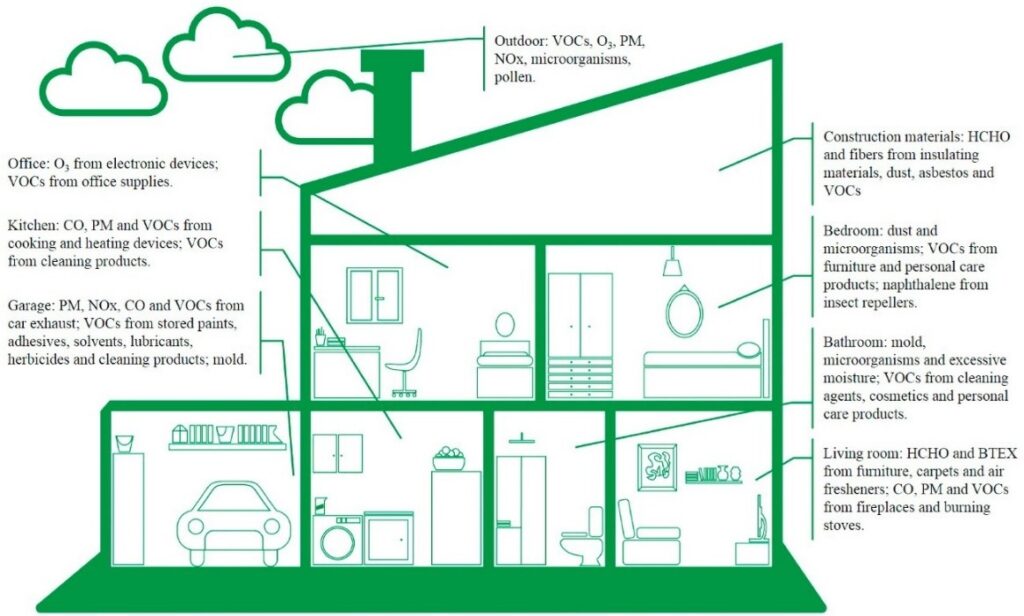Historically, much attention has been paid to out door air quality, especially pollution generated by cars and factories, and its impact on health. While this concern for outdoor air is well-founded, and certainly of concern, its “sister”, indoor air quality, is often overshadowed, when in reality, the concentration of pollutants and the time of exposure to them is much higher.

Think about it: How much time do you spend on indoor? You have dinner, sleep in a closed room, wake up, go to work (probably by bus or car), go to work, where you spend eight hours, return home by car, and then, it will depend on the activities of each one, but, unless you do some sport or activity that is exclusively outdoors, you will still be indoors. In other words, let´s suppose that, if you have dinner at 22h, probably until you leave work and eatl (if you leave at 15h, and as soon as you arrive you eat), you will have been almost continuously inside an enclosed space for 18 hours. 18 hours out of 24 hours indoors at least.
With this in mind, it certainly makes sense to be concerned about what we breathe at home, or at work, especially as studies attributte more than five million premature deaths per year to poor indoor air quality. On the other hand, there are also many diseases that are associated with, or exarcebated by, poor indoor air quality : asthma, chronic obstructive pulmonary disease (known as COPD), cardiovascular disease, headaches and migraines.
This is where the K-HEALTHinAIR project comes in, a project that seeks to identify and address the different pollutants present indoors, and assess how they affect human health. To do this, it combines low-cost air monitoring technologies in different spaces (hospitals, classrooms, homes, residences…) with data analysis tools to understand exposure to these pollutants, and propose innovative solutions to mitigate their effects.
At this point, the question of what are these harmful pollutants that we breathe in on a daily basis, and their sources, is likely to arise: some of the most common major indoor pollutants are CO2, which comes from human respiration and can cause fatigue, headaches, or decreased concentration; formaldehyde, present in furniture, paints, building materials, cigarette smoke, causing eye, nose and throat irritation, bronchitis and related to an increased risk of cancer; particulate matter (PM), originating from cooking and combustion activities in general. Smaller particles can enter the lungs, causing respiratory and cardiovascular problems; volatile organic compounds (VOCs), originating from cooking, cigarette smoke, air fresheners, paints… They can cause dizziness, asthma, irritation; and nitrogen dioxide (N2O), present due to cooking or gas cooker combustion, or fuel combustion. This pollutant can worsen respiratory symptoms2. In addition, outdoor sources can also influence indoor air quality.

In other words, many of the activities or materials used on a daily basis can be a source of indoor pollutants. But just as these pollutants have ‘simple and common’ sources, so do some of the strategies you can apply to counteract them: regular ventilation (yes, it is winter now and on days when temperatures are close to Siberian, it is not pleasant, but a few minutes is probably enough) is always a good way. Or in the case of cooking, the use of extractor hoods. Reducing the use of air fresheners can also help to reduce these pollutants and thus improve indoor air quality. As explained above, smoking is also very harmful, so ideally this activity should not be carried out indoors. These are examples of simple activities to do to improve indoor air quality, and therefore your quality of life.
Ultimately, indoor air quality is a fundamental issue that should not be overlooked. Although sources of pollution in the home or indoors may seem unavoidable, small changes in our daily habits and conscious choices can make a big difference to our health and well-being. It’s not just about improving the environment we live in, but about protecting ourselves and our families from the negative effects of polluted air. After all, if we spend so much of our lives indoors, why not make those spaces a place where breathing is synonymous with health and tranquillity?
1 González-Martín J, Kraakman NJR, Pérez C, Lebrero R, Muñoz R. A state–of–the-art review on indoor air pollution and strategies for indoor air pollution control. Chemosphere. 2021;262:128376. doi:10.1016/J.CHEMOSPHERE.2020.128376
2 Mannan M, Al-Ghamdi SG. Indoor Air Quality in Buildings: A Comprehensive Review on the Factors Influencing Air Pollution in Residential and Commercial Structure. International Journal of Environmental Research and Public Health 2021, Vol 18, Page 3276. 2021;18(6):3276. doi:10.3390/IJERPH18063276
- Indoor air quality: What you don´t see, but what affects you - 7 February 2025

